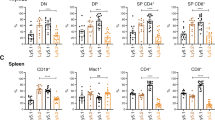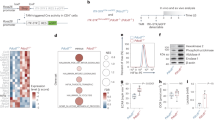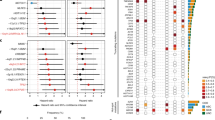Abstract
T lymphocyte non-Hodgkin's lymphoma (T-NHL) represents an aggressive and largely therapy-resistant subtype of lymphoid malignancies. As deregulated apoptosis is a frequent hallmark of lymphomagenesis, we analyzed gene expression profiles and protein levels of primary human T-NHL samples for various apoptotic regulators. We identified the apoptotic regulator MCL-1 as the only pro-survival BCL-2 family member to be highly expressed throughout all human T-NHL subtypes. Functional validation of pro-survival protein members of the BCL-2 family in two independent T-NHL mouse models identified that the partial loss of Mcl-1 significantly delayed T-NHL development in vivo. Moreover, the inducible reduction of MCL-1 protein levels in lymphoma-burdened mice severely impaired the continued survival of T-NHL cells, increased their susceptibility to chemotherapeutics and delayed lymphoma progression. Lymphoma viability remained unaffected by the genetic deletion or pharmacological inhibition of all alternative BCL-2 family members. Consistent with a therapeutic window for MCL-1 treatment within the context of the whole organism, we observed an only minimal toxicity after systemic heterozygous loss of Mcl-1 in vivo. We conclude that re-activation of mitochondrial apoptosis by blockade of MCL-1 represents a promising therapeutic strategy to treat T-cell lymphoma.
This is a preview of subscription content, access via your institution
Access options
Subscribe to this journal
Receive 12 print issues and online access
$259.00 per year
only $21.58 per issue
Buy this article
- Purchase on Springer Link
- Instant access to full article PDF
Prices may be subject to local taxes which are calculated during checkout






Similar content being viewed by others
References
Swerdlow SH, Campo E, Harris NL, Jaffe ES, Pileri SA, Stein H et al. WHO Classification of Tumours of Haematopoietic and Lymphoid Tissues, 4th edn. WHO Classification of Tumours, Volume 2 World Health Organization Press, 2008.
Iqbal J, Weisenburger DD, Chowdhury A, Tsai MY, Srivastava G, Greiner TC et al. Natural killer cell lymphoma shares strikingly similar molecular features with a group of non-hepatosplenic γδ T-cell lymphoma and is highly sensitive to a novel aurora kinase A inhibitor in vitro. Leukemia 2011; 25: 1377–1377.
van Doorn R, van Kester MS, Dijkman R, Vermeer MH, Mulder AA, Szuhai K et al. Oncogenomic analysis of mycosis fungoides reveals major differences with Sezary syndrome. Blood 2009; 113: 127–136.
Travert M, Huang Y, de Leval L, Martin-Garcia N, Delfau-Larue MH, Berger F et al. Molecular features of hepatosplenic T-cell lymphoma unravels potential novel therapeutic targets. Blood 2012; 119: 5795–5806.
de Leval L, Rickman DS, Thielen C, Reynies AD, Huang YL, Delsol G et al. The gene expression profile of nodal peripheral T-cell lymphoma demonstrates a molecular link between angioimmunoblastic T-cell lymphoma (AITL) and follicular helper T (TFH) cells. Blood 2007; 109: 4952–4963.
Dürig J, Bug S, Klein-Hitpass L, Boes T, Jöns T, Martin-Subero JI et al. Combined single nucleotide polymorphism-based genomic mapping and global gene expression profiling identifies novel chromosomal imbalances, mechanisms and candidate genes important in the pathogenesis of T-cell prolymphocytic leukemia with inv(14)(q11q32). Cell Death Differ 2007; 21: 2153–2163.
Shin J, Monti S, Aires DJ, Duvic M, Golub T, Jones DA et al. Lesional gene expression profiling in cutaneous T-cell lymphoma reveals natural clusters associated with disease outcome. Blood 2007; 110: 3015–3027.
Lamant L, Reynies AD, Duplantier MM, Rickman DS, Sabourdy F, Giuriato S et al. Gene-expression profiling of systemic anaplastic large-cell lymphoma reveals differences based on ALK status and two distinct morphologic ALK+ subtypes. Blood 2007; 109: 2156–2164.
Tan S-Y, Ooi A-S, Ang M-K, Koh M, Wong J-C, Dykema K et al. leu2010295a. Leukemia 2011; 25: 555–557.
Huang Y, de Reynies A, de Leval L, Ghazi B, Martin-Garcia N, Travert M et al. Gene expression profiling identifies emerging oncogenic pathways operating in extranodal NK/T-cell lymphoma, nasal type. Blood 2010; 115: 1226–1237.
Lukk M, Kapushesky M, Nikkilä J, Parkinson H, Goncalves A, Huber W et al. A global map of human gene expression. Nat Biotechnol 2010; 28: 322–324.
Shah MV, Zhang R, Irby R, Kothapalli R, Liu X, Arrington T et al. Molecular profiling of LGL leukemia reveals role of sphingolipid signaling in survival of cytotoxic lymphocytes. Blood 2008; 112: 770–781.
Rodríguez-Caballero A, García-Montero AC, Bárcena P, Almeida J, Ruiz-Cabello F, Tabernero MD et al. Expanded cells in monoclonal TCR-alphabeta+/CD4+/NKa+/CD8-/+dim T-LGL lymphocytosis recognize hCMV antigens. Blood 2008; 112: 4609–4616.
Warner K, Weit N, Crispatzu G, Admirand J, Jones D, Herling M . T-cell receptor signaling in peripheral T-cell lymphoma - a review of patterns of alterations in a central growth regulatory pathway. Curr Hematol Malig Rep 2013; 8: 163–172.
Warner K, Crispatzu G, Al-Ghaili N, Weit N, Florou V, You MJ et al. Models for mature T-cell lymphomas—a critical appraisal of experimental systems and their contribution to current T-cell tumorigenic concepts. Crit Rev Oncol Hematol 2013; 88: 680–695.
Nelson M, Horsman DE, Weisenburger DD, Gascoyne RD, Dave BJ, Loberiza FR et al. Cytogenetic abnormalities and clinical correlations in peripheral T-cell lymphoma. Br J Haematol 2008; 141: 461–469.
Schwickart M, Huang X, Lill JR, Liu J, Ferrando R, French DM et al. Deubiquitinase USP9X stabilizes MCL1 and promotes tumour cell survival. Nature 2010; 463: 103–107.
Piccaluga PP, Fuligni F, De Leo A, Bertuzzi C, Rossi M, Bacci F et al. Molecular profiling improves classification and prognostication of nodal peripheral T-cell lymphomas: results of a Phase III diagnostic accuracy study. J Clin Oncol 2013; 31: 3019–3025.
Iqbal J, Weisenburger DD, Greiner TC, Vose JM, McKeithan T, Kucuk C et al. Molecular signatures to improve diagnosis in peripheral T-cell lymphoma and prognostication in angioimmunoblastic T-cell lymphoma. Blood 2010; 115: 1026–1036.
Piccaluga PP, Agostinelli C, Califano A, Rossi M, Basso K, Zupo S et al. Gene expression analysis of peripheral T cell lymphoma, unspecified, reveals distinct profiles and new potential therapeutic targets. J Clin Invest 2007; 117: 823–834.
Pileri SA, Piccaluga PP . New molecular insights into peripheral T cell lymphomas. J Clin Invest 2012; 122: 3448–3455.
Nakahata S, Ichikawa T, Maneesaay P, Saito Y, Nagai K, Tamura T et al. Loss of NDRG2 expression activates PI3K-AKT signalling via PTEN phosphorylation in ATLL and other cancers. Nat Commun 2013; 5: 3393–3393.
Pechloff K, Holch J, Ferch U, Schweneker M, Brunner K, Kremer M et al. The fusion kinase ITK-SYK mimics a T cell receptor signal and drives oncogenesis in conditional mouse models of peripheral T cell lymphoma. J Exp Med 2010; 207: 1031–1044.
Youle RJ, Strasser A . The BCL-2 protein family: opposing activities that mediate cell death. Nat Rev Mol Cell Biol 2008; 9: 47–59.
Hanahan D, Weinberg RA . Hallmarks of cancer: the next generation. Cell 2011; 144: 29–29.
Kaplan HS . Influence of thymectomy, splenectomy, and gonadectomy on incidence of radiation-induced lymphoid tumors in strain C57 black mice. J Natl Cancer Inst 1950; 11: 83–90.
Kelly PN, White MJ, Goschnick MW, Fairfax KA, Tarlinton DM, Kinkel SA et al. Individual and overlapping roles of BH3-only proteins Bim and Bad in apoptosis of lymphocytes and platelets and in suppression of thymic lymphoma development. Cell Death Differ 2010; 17: 1655–1664.
Strasser A, Harris AW, Bath ML, Cory S . Novel primitive lymphoid tumours induced in transgenic mice by cooperation between myc and bcl-2. Nature 1990; 348: 331–333.
Michalak EM, Vandenberg CJ, Delbridge ARD, Wu L, Scott CL, Adams JM et al. Apoptosis-promoted tumorigenesis: gamma-irradiation-induced thymic lymphomagenesis requires Puma-driven leukocyte death. Genes Dev 2010; 24: 1608–1613.
Kelly PN, Grabow S, Delbridge ARD, Strasser A, Adams JM . Endogenous Bcl-xL is essential for Myc-driven lymphomagenesis in mice. Blood 2011; 118: 6380–6386.
Kelly GL, Grabow S, Glaser SP, Fitzsimmons L, Aubrey BJ, Okamoto T et al. Targeting of MCL-1 kills MYC-driven mouse and human lymphomas even when they bear mutations in p53. Genes Dev 2014; 28: 58–70.
Hata AN, Engelman JA, Faber AC . The BCL2 family: key mediators of the apoptotic response to targeted anticancer therapeutics. Cancer Discov 2015; 5: 475–487.
Vikstrom I, Carotta S, Luthje K, Peperzak V, Jost PJ, Glaser S et al. Mcl-1 is essential for germinal center formation and B cell memory. Science 2010; 330: 1095–1099.
Opferman JT, Letai A, Beard C, Sorcinelli MD, Ong CC, Korsmeyer SJ . Development and maintenance of B and T lymphocytes requires antiapoptotic MCL-1. Nature 2003; 426: 671–676.
Dzhagalov I, Dunkle A, He Y-W . The anti-apoptotic Bcl-2 family member Mcl-1 promotes T lymphocyte survival at multiple stages. J Immunol 2008; 181: 521–528.
Campbell KJ, Gray DHD, Anstee N, Strasser A, Cory S . Elevated Mcl-1 inhibits thymocyte apoptosis and alters thymic selection. Cell Death Differ 2012; 19: 1962–1971.
Wagner KU, Claudio E, Rucker EB, Riedlinger G, Broussard C, Schwartzberg PL et al. Conditional deletion of the Bcl-x gene from erythroid cells results in hemolytic anemia and profound splenomegaly. Development 2000; 127: 4949–4958.
Veis DJ, Sentman CL, Bach EA, Korsmeyer SJ . Expression of the Bcl-2 protein in murine and human thymocytes and in peripheral T lymphocytes. J Immunol 1993; 151: 2546–2554.
Nakayama K-I, Negishi I, Kuida K, Shinkai Y, Louie MC, Fields LE et al. Disappearance of the lymphoid system in Bcl-2 homozygous mutant chimeric mice. Science 1993; 261: 1584–1588.
Wojciechowski S, Tripathi P, Bourdeau T, Acero L, Grimes HL, Katz JD et al. Bim/Bcl-2 balance is critical for maintaining naive and memory T cell homeostasis. Nature 2007; 204: 1665–1675.
Grillot DA, Merino R, Núñez G . Bcl-XL displays restricted distribution during T cell development and inhibits multiple forms of apoptosis but not clonal deletion in transgenic mice. J Exp Med 1995; 182: 1973–1983.
Motoyama N, Wang F, Roth KA, Sawa H, Nakayama K, Nakayama K et al. Massive cell death of immature hematopoietic cells and neurons in Bcl-x-deficient mice. Science 1995; 267: 1506–1510.
Zhang N, He Y-W . The antiapoptotic protein Bcl-xL is dispensable for the development of effector and memory T lymphocytes. J Immunol 2005; 174: 6967–6973.
Grabow S, Delbridge ARD, Valente LJ, Strasser A . MCL-1 but not BCL-XL is critical for the development and sustained expansion of thymic lymphoma in p53-deficient mice. Blood 2014; 124: 3939–3946.
Machulla H-J, Blocher A, Kuntzsch M, Piert M, Wei R, Grierson JR . Simplified labeling approach for synthesizing 3′-deoxy-3′-[18 F] fluorothymidine ([18 F] FLT). J Radioanal Nucl Chem 2000; 243: 843–846.
Abulwerdi F, Liao C, Liu M, Azmi AS, Aboukameel A, Mady AS et al. A novel small-molecular inhibitor of mcl-1 blocks pancreatic cancer growth in vitro and in vivo. Mol Cancer Ther 2014; 13: 565–575.
Oltersdorf T, Elmore SW, Shoemaker AR, Armstrong RC, Augeri DJ, Belli BA et al. An inhibitor of Bcl-2 family proteins induces regression of solid tumours. Nature 2005; 435: 677–681.
International T-Cell Lymphoma Project. International Peripheral T-Cell and Natural Killer/T-Cell Lymphoma Study: pathology findings and clinical outcomes. J Clin Oncol 2008; 26: 4124–4130.
Thorns C, Bastian B, Pinkel D, Roydasgupta R, Fridlyand J, Merz H et al. Chromosomal aberrations in angioimmunoblastic T-cell lymphoma and peripheral T-cell lymphoma unspecified: a matrix-based CGH approach. Genes Chromosome Cancer 2006; 46: 37–44.
Zettl A, Rüdiger T, Konrad M-A, Chott A, Simonitsch-Klupp I, Sonnen R et al. Genomic profiling of peripheral T-cell lymphoma, unspecified, and anaplastic large T-cell lymphoma delineates novel recurrent chromosomal alterations. Am J Pathol 2004; 164: 1837–1848.
Tsukasaki K . Comparative genomic hybridization analysis in adult T-cell leukemia/lymphoma: correlation with clinical course. Blood 2001; 97: 3875–3881.
Rassidakis GZ, Jones D, Lai R, Ramalingam P, Sarris AH, McDonnell TJ et al. BCL-2 family proteins in peripheral T-cell lymphomas: correlation with tumour apoptosis and proliferation. J Pathol 2003; 200: 240–248.
Zhang C-L, Kamarashev J, Qin J-Z, Burg GN, Dummer R, Döbbeling U . Expression of apoptosis regulators in cutaneous T-cell lymphoma (CTCL) cells. J Pathol 2003; 200: 249–254.
Perciavalle RM, Opferman JT . Delving deeper: MCL-1's contributions to normal and cancer biology. Trends Cell Biol 2013; 23: 22–29.
Merkel O, Hamacher F, Laimer D, Sifft E, Trajanoski Z, Scheideler M et al. Identification of differential and functionally active miRNAs in both anaplastic lymphoma kinase (ALK)+ and ALK- anaplastic large-cell lymphoma. Proc Natl Acad Sci USA 2010; 107: 16228–16233.
Iqbal J, Wright G, Wang C, Rosenwald A, Gascoyne RD, Weisenburger DD et al. Gene expression signatures delineate biologic and prognostic subgroups in peripheral T-cell lymphoma. Blood 2014; 123: 2915–2923.
Vogler M . BCL2A1: the underdog in the BCL2 family. Cell Death Differ 2011; 19: 67–74.
Glaser SP, Lee EF, Trounson E, Bouillet P, Wei A, Fairlie WD et al. Anti-apoptotic Mcl-1 is essential for the development and sustained growth of acute myeloid leukemia. Genes Dev 2012; 26: 120–125.
Xiang Z, Luo H, Payton JE, Cain J, Ley TJ, Opferman JT et al. Mcl1 haploinsufficiency protects mice from Myc-induced acute myeloid leukemia. J Clin Invest 2010; 120: 2109–2118.
Koss B, Morrison J, Perciavalle RM, Singh H, Rehg JE, Williams RT et al. Requirement for antiapoptotic MCL-1 in the survival of BCR-ABL B-lineage acute lymphoblastic leukemia. Blood 2013; 122: 1587–1598.
Leverson JD, Zhang H, Chen J, Tahir SK, Phillips DC, Xue J et al. Potent and selective small-molecule MCL-1 inhibitors demonstrate on-target cancer cell killing activity as single agents and in combination with ABT-263 (navitoclax). Cell Death Dis 2015; 6: e1590.
Rinkenberger JL, Horning S, Klocke B, Roth K, Korsmeyer SJ . Mcl-1 deficiency results in peri-implantation embryonic lethality. Genes Dev 2000; 14: 23–27.
Opferman JT, Iwasaki H, Ong CC, Suh H, Mizuno S-I, Akashi K et al. Obligate role of anti-apoptotic MCL-1 in the survival of hematopoietic stem cells. Science 2005; 307: 1101–1104.
Seibler J . Rapid generation of inducible mouse mutants. Nucleic Acids Res 2003; 31: 12e–12e.
Peperzak V, Vikström I, Walker J, Glaser SP, LePage M, Coquery CM et al. Mcl-1 is essential for the survival of plasma cells. Nat Immunol 2013; 14: 290–297.
Wang X, Bathina M, Lynch J, Koss B, Calabrese C, Frase S et al. Deletion of MCL-1 causes lethal cardiac failure and mitochondrial dysfunction. Genes Dev 2013; 27: 1351–1364.
Thomas RL, Roberts DJ, Kubli DA, Lee Y, Quinsay MN, Owens JB et al. Loss of MCL-1 leads to impaired autophagy and rapid development of heart failure. Genes Dev 2013; 27: 1365–1377.
Lee PP, Fitzpatrick DR, Beard C, Jessup HK, Lehar S, Makar KW et al. A critical role for Dnmt1 and DNA methylation in T cell development, function, and survival. Immunity 2001; 15: 763–774.
Acknowledgements
We thank Stephanie Rott and Smaro Beskeli for excellent technical assistance. PJJ was supported by the DFG Research Unit FOR2036, Max Eder-Program grants from the Deutsche Krebshilfe (program nos. 109310 and 111738), a Human Frontiers Science Program grant (program no. RGY0073/ 2012), the German Jose Carreras Leukemia Foundation grant (DJCLS R 12/22) and a grant from the Else Kröner Fresenius-Stiftung (2014-A185). MH (Cologne) was supported by the DFG Research Unit 'CONTROL-T' FOR1961 (HE3553/4-1) and Max Eder-Program grants from the Deutsche Krebshilfe (program no. 108029). SN was supported by the DFG Research Unit 'CONTROL-T' FOR1961 (NE1438/4-1). GLK and AS were supported by fellowships and grants from the NHMRC and the Redstone Foundation Trust; AS by LLS and Cancer Council of Victoria. MH (Munich) was supported by an ERC starting grant (LiverCancerMechanisms), the Stiftung Experimentelle Biomedizin and the Helmholtz-Zentrum.
Author contributions
Sabine Spinner performed experiments and wrote the manuscript. Ji-Hee Yi, Tim Schrader, Henriette Bendz, Petra Mayer, Ulrike Höckendorf, Nicole Müller and Monica Yabal performed experiments. Gemma L Kelly and Andreas Strasser generated the CreERT2 Mcl-1fl/+ and CreERT2 Mcl-1+/+ lymphoma cells. Enkhtsetseg Munkhbaatar performed histological analysis of murine T-NHL samples. Giuliano Crispatzu and Marco Herling integrated and summarized the mRNA expression data on human T-NHL samples. Sylvia Hartman and Martin-Leo Hansmann provided and stained histological sections of human PTCL, ALCL and AITL samples. Zoulei Lei evaluated PET-CT results on mice transplanted with T-NHL cells. Konstanze Pechloff and Jürgen Ruland generated ITK-SYK CD4Cre mice and provided critical reagents. Mathias Heikenwälder and Sebastian Newrzela provided critical reagents and advice. Christian Peschel, Andreas Strasser, Marco Herling, Ulrich Keller and Jürgen Ruland supported the project by critical discussion. Philipp J Jost designed and supervised the project and wrote the manuscript.
Author information
Authors and Affiliations
Corresponding author
Ethics declarations
Competing interests
GLK and AS work at the Walter and Eliza Hall Institute. This Institute receives milestone payments from Genentech Inc. and AbbVie for the development of BH3 mimetic drugs for cancer therapy. All the other authors declare no conflict of interest.
Additional information
Supplementary Information accompanies this paper on the Leukemia website
Supplementary information
Rights and permissions
About this article
Cite this article
Spinner, S., Crispatzu, G., Yi, JH. et al. Re-activation of mitochondrial apoptosis inhibits T-cell lymphoma survival and treatment resistance. Leukemia 30, 1520–1530 (2016). https://doi.org/10.1038/leu.2016.49
Received:
Revised:
Accepted:
Published:
Issue Date:
DOI: https://doi.org/10.1038/leu.2016.49



